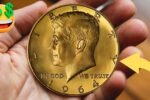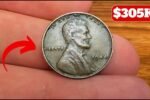What if the penny buried in your change jar or tucked away in an old wallet turned out to be worth $3.3 million? As unbelievable as it sounds, this has happened—thanks to the incredibly rare 1943 copper Lincoln Wheat Penny. Despite its face value being just one cent, this historic mistake coin has fetched millions at auction and may still be floating around in everyday circulation.
Canada GST Payment 2025: Extra Payment Date and Amount Revealed
Yes, you read that right—this humble penny could still be hiding in plain sight.
The Fascinating Story of the Lincoln Wheat Penny
The Lincoln Wheat Penny isn’t just pocket change—it’s a piece of American history. Introduced in 1909 to commemorate Abraham Lincoln’s 100th birthday, it was the first U.S. coin to feature a real person. The obverse bears Lincoln’s iconic profile, while the reverse displays two wheat stalks curving along the sides of the coin, giving it its nickname—“Wheat Penny.”
Minted until 1958, the Lincoln Wheat Penny holds a cherished spot in the hearts of collectors. But none are as famous or valuable as the mysterious 1943 copper version, born from a wartime mix-up.
The Accidental Creation of a Multi-Million Dollar Coin
In 1943, with World War II demanding vast amounts of copper for ammunition and military equipment, the U.S. Mint decided to make pennies from zinc-coated steel to conserve copper. However, a few copper blanks from 1942 were accidentally left in the presses.
These leftover copper planchets were struck with the 1943 design, creating one of the rarest and most sought-after coins in American numismatic history—the 1943 copper Lincoln Wheat Penny.
Only a handful were ever produced, and fewer than 20 authentic specimens are known to exist. One of them sold for a jaw-dropping $3.3 million, transforming a one-cent coin into a multimillion-dollar marvel.
Could You Have a $3.3 Million Penny?
It might sound like a fairy tale, but ordinary people have found these valuable coins in the most unexpected places—piggy banks, old coin jars, even pocket change from a candy store. So, how can you tell if your penny is the real deal?
Here’s how to identify a genuine 1943 copper Lincoln Wheat Penny:
-
Check the year: It must say 1943.
-
Examine the color: Steel pennies have a silver-gray tone, while copper ones are reddish-brown.
-
Use a magnet: Copper isn’t magnetic—steel is. If it sticks, it’s not copper.
-
Listen to the sound: Tap it gently—copper has a duller ring compared to steel.
Be cautious, though. There are many convincing fakes out there. Some 1943 steel pennies are plated with copper, and some older pennies have been altered to appear like the rare 1943 copper version.
Also Read – June 2025 Double Stimulus Payment: $2,250 + $2,750 One-Time Relief Incoming
Fake Lincoln Wheat Pennies: Know the Red Flags
Scammers often try to replicate the valuable Lincoln Wheat Penny using shady tactics. These include:
-
Copper-plating common 1943 steel pennies.
-
Altering the date on similar coins, such as from 1945 or 1948.
-
Filing or engraving coins to fake specific mint errors.
To avoid being misled, always turn to professional coin graders. Trusted organizations like PCGS (Professional Coin Grading Service) and NGC (Numismatic Guaranty Corporation) can examine your coin, verify its authenticity, and even provide a sealed, tamper-proof case with certification.
Where Rare Lincoln Wheat Pennies Have Been Discovered
Some of these ultra-rare coins have surfaced under surprisingly normal circumstances:
-
A child found one in candy store change in the 1950s.
-
Others were passed down through generations in family coin jars.
-
Some were discovered in unsearched bank rolls of pennies.
Yes, the dream is still alive—you might just find a Lincoln Wheat Penny worth millions hiding in your own home.
Other Valuable Lincoln Wheat Pennies to Look For
While the 1943 copper penny steals the spotlight, there are several other rare Lincoln Wheat Pennies that are also worth serious money:
-
1909-S VDB – The debut coin featuring designer Victor D. Brenner’s initials. Worth over $100,000.
-
1914-D – A low-mintage coin from Denver. Highly sought after.
-
1922 “No D” – Minted without the Denver mintmark due to a filled die. Very rare.
-
1955 Double Die – One of the most famous error coins, showing doubled text. These can be worth over $50,000.
Each of these rare coins tells its own story and adds to the rich legacy of the Lincoln Wheat Penny.
What to Do If You Think You’ve Found a Rare Penny
If you suspect that a coin in your collection could be valuable, take these steps:
-
Do not clean it – Cleaning can reduce its value.
-
Handle with care – Always hold coins by the edges.
-
Store it safely – Use soft holders or coin flips to protect it.
-
Get it authenticated – PCGS or NGC can help you verify its true value.
-
Explore your selling options – Reputable coin dealers, auctions, and private collectors are potential buyers.
Why the Lincoln Wheat Penny Still Captivates Collectors
There’s something irresistible about the idea that a multimillion-dollar coin could be hiding in a pocket or an old jar. The Lincoln Wheat Penny has inspired generations of collectors and treasure hunters to chase that dream.
It’s more than just a coin—it’s a symbol of history, mystery, and hope. Whether you’re a seasoned collector or a curious beginner, the excitement of possibly uncovering a lost gem is what makes the hunt so thrilling.
Final Thoughts
The story of the 1943 copper Lincoln Wheat Penny is a reminder that treasures can still be found in the most unexpected places. One cent can be worth $3.3 million—not because of its size, but because of its story, rarity, and the circumstances of history.
So next time you hear the clink of coins in your pocket or find a forgotten penny on the floor, take a closer look. You might just be holding onto one of the rarest and most valuable coins in America.
SASSA Grants 2025: Can You Still Collect Without an ID? New Rules Explained
Some Important Link
| Telegram Group | Click Here |
| WhatsApp Group | Click Here |
| Home Page | Click Here |






